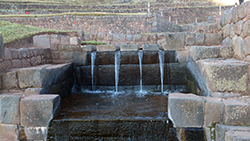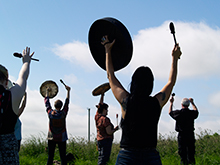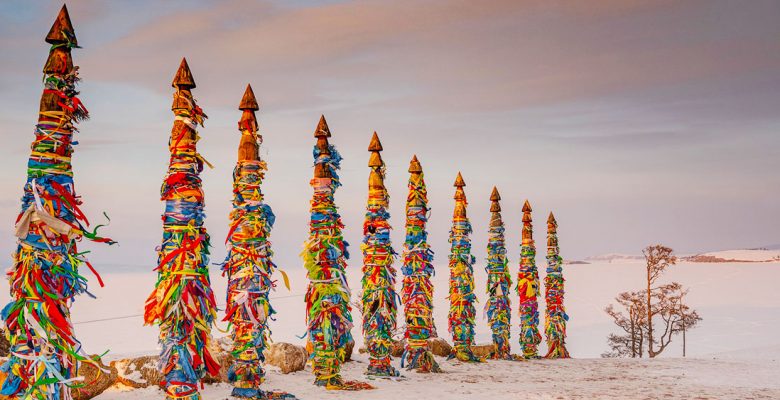The Shaman – Spirit Relationship
Shamans and spirits have shared a mutual affinity since earliest recorded history. The perennial bond between human practitioner and spirit is at the heart of shamanism. It is through relationship with spirits that shamans derive their power to help and to heal – and through that same relationship a shaman’s power can be taken away. The shaman humbly honours the spirits – who are sources of that invisible healing energy, the sacred life force in all things. Together, both shaman and spirit join in feats of holy work at once profound and practical. They meet in realities where perceptions of separation dissolve, moving to orchestrate harmonious flows back into life.

Entering the world of spirit is for the shaman like visiting a foreign land. The shaman depends upon the hospitality of spirits who reveal the hidden energies directing the physical world. What the spirit illuminates, the shaman sees through the penetrating eyes of altered states. In accord with spirit, the shaman focuses and conducts healing energies between physical and hidden realms, bringing balance to living existence. In journeys with spirits, a practitioner learns again and again to see the connection in all things. Each experience forms new relationships with balancing life force in ways that can appear miraculous to the everyday eye.
The enigmatic tie between shaman and spirit is apprehended only through direct experience, but the core of the work is ultimately down-to-earth. Both shaman and spirits understand their business is about healing, harmonizing, and making whole. Their partnership teaches shamans to navigate the ever-spontaneous flows of the universe – and to know the multifaceted nature of spirit. Shamanic mastery amidst the vast universe requires discipline, discernment, control, humility, commitment, courage, and humor.
The Mastery of Relationship

The wise shaman does not presume mastery over any spirit, much less over an inscrutable cosmos. Humble before an ever mysterious existence, the seasoned shaman seeks mastery of self in seeking right relationship with spirit.
Just as shamans seek to balance energies between material and spirit worlds, they must learn to balance boundaries between self and spirit. Every relationship is unique, demanding a different dance of energies. Some spirits are more ready to engage, others not, and still others even adversarial. From among the unending array of cosmic spirits, shamans must make allies while managing the course of healing.
As shamans takes charge of establishing specific goals, they receive divine direction with humility – rooting out disease, healing trauma, and divining guidance for the community. Likewise, they take action to do the necessary work of directing energies toward healing. In the company of spirit, the shaman’s cosmic terrain becomes more familiar with each unique journey. The shaman, translating healing into meaning, is part poet, priest, physician, and emissary.
Over time, experienced shamans come to know spirits by their forms, names, and intents – whether benevolent or malevolent. In accord with specific needs, the shaman forges trusted partnerships and directs the power of spirit to dissolve disharmonies, redirect misplaced energies, or reintegrate lost souls. Operating with the accuracy of a surgeon, the discerning shaman aligns harmonious life flows without judgment.
Shamanic practices and the ways of perceiving spirits vary around the world. But clear connection to spirit is at the crux of every shaman’s power to heal. Whatever their cultural garb, language, or ritual, precision is essential to shaman – as with states of embodiment when the practitioner intentionally brings a known helping spirit into the body for healing, extractions, or cleansing work. But without exacting skill, practices of embodiment could devolve into possession of unknown origin, overpowering the inexperienced practitioner’s intentions with incoherent energies of all types. Experience and expert training hones the talent and skill of the shaman toward mastery. Having first mastered the self, the shaman is poised to work powerfully with the appropriate helping spirits for all types of healing and divination.
The Nature of the Working Relationship

The shaman-spirit dynamic is as practical as any working relationship. Like coworkers meeting in an office, they rely upon basic ground rules: mutual respect, cooperation, clear communication, and consistent effort on each one’s part to do the best job possible. Like any close collaboration, both practitioner and spirit develop a mutual trust, made deeper through the inherent sacredness of their heart-centered work. Shamans, working from deep awareness of Oneness, can experience ecstatic states – but the master stays focused on the work at hand.
Every working relationship is different, just as each shaman and spirit is unique. A practicing shaman develops specific types of working arrangements with different spirits, in accord with the healing or guidance needed by an individual or community. The trained shaman is introduced to an assortment of traditional, local, or cross-cultural spirits. Shamans also develop techniques for acquiring new personal relationships from among spirits varying by geographies, powers, teachings, or tasks. Whether connected to new or long-established relationships, the shaman’s work is never routine. Each journey is an excursion into the dynamic variations of creation. The shaman’s work is not faith-based. Working directly with healing life force, the ability to heal emerges from direct experience with the spirit world.
Cultivating Shaman-Spirit Relationship over Time
Like any relationship, the one between shaman and spirit must be nurtured to survive and flourish. The earthbound shaman, venturing into the world of spirit, cannot expect the attentions of any spirit. No matter how at home shaman might feel in the spirit world, they have no guarantee of developing ties with any spirit. Like aliens in a foreign land, shamans are wise to remain humble in all their connections.
In many cultures, like the Eskimo, the shaman or angakok must be specifically chosen by a spirit. In other cultures, practitioners can seek out spirits. Whether being chosen or seeking to choose, humility is the rule in all cultures. Anyone, man or woman, can be a shaman. But without a humble countenance, the shaman swiftly loses the help of spirits, and thus the power to heal.
Shamanism is the art of cultivating connection with spirits consistently over time through communication, attention, and gratitude. Shamans who practice being present to spirit commit themselves to real relationships – from cosmic to community. Challenging, deeply personal, and always practical, those relationships to spirit yield worldly miracles.
Shamanic training courses at Green Tara College
 The starting point for all our shamanic training is the Foundation in Shamanism
The starting point for all our shamanic training is the Foundation in Shamanism
https://www.greentara.ie/zoom-shamanism/
The program is as follows:
- Foundation in Shamanism – this provides the basic skills. Details are below. This course is 2 hours per week, every Tuesday. [more details]
- Intermediate Shamanism – this is a 6-month course, 2 hours per week, every Thursday. Intermediate Shamanic training assumes certain key shamanic skills, taught in the Foundation in Shamanism course. However, if you already have those, you can enter this course directly, or take Foundation in Shamanism at the same time. The main focus is building your psychic power and a number of empowering initiations from the Q’ero tradition (Peru). [more details]
- Shamanic Practitioner – This is a 1-year course, with an optional second year for advanced work. This course assumes the skills developed in the previous classes and will focus on working with clients. We do not think someone can do this safely without the skills and training from the previous courses, though people can acquire those skills elsewhere – we are not requiring they have attended our classes, only that they are ready for the heavy-duty work of healing others. [more details]

